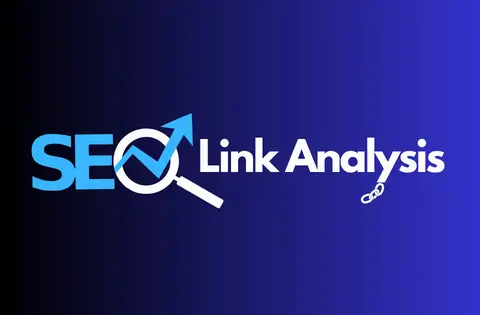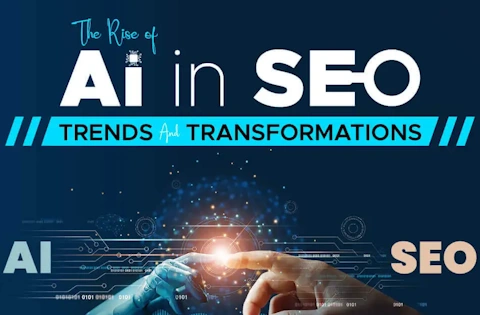The Future of Link Analysis: How AI is Detecting and Valuing Backlinks?

For anyone aiming to improve their digital presence, a deep dive into SEO (Search Engine Optimization) and link analysis with AI is essential. Links when applied correctly, dramatically improve your website’s SEO and position your pages on top of SERPs. Therefore it is pivotal for driving organic traffic to your site and broadening your brand’s visibility.
Link analysis is a key component of SEO, and whether you do it manually or use SEO tools it becomes a priority for every website owner who wants to improve their site’s rankings. It mainly includes researching the volume and quality of backlinks from other websites. These backlinks can be like thousands of online recommendations, indicating to search engines the value and relevance of your website.
But as you know, today AI enter everywhere including AI in SEO, the landscape of SEO and link analysis is also rapidly changing. AI technology quickly enhances or even replaces traditional link-building methods. Therefore the shift to AI-driven efficiency is transforming SEO methodologies and introducing new opportunities to produce more reliable ranking results.
How Important are Backlinks & Link Analysis for Websites Today?
Backlinks are critically important in increasing the visibility and rank of a website on search engine result pages (SERPs). Search engines, like Google, crawl the web using algorithms that give a lot of weight to backlinks when ranking certain pages based on keywords and phrases.
A website that has numerous high-quality backlinks typically indicates valuable, pertinent content that meets user needs and is rewarded with higher placements in SERPs.
These pivotal links serve two primary SEO functions – relevance and authority.
Relevance is about matching your content with the user’s search intentions, and acquiring backlinks from industry-related sites can demonstrate to search engines that your content is relevant.
Authority deals with your website’s reliability and trust level. Earning backlinks from well-established, authoritative websites can significantly boost your site’s authority in relation.
Getting a high rank without many backlinks pointing to your site can be increasingly difficult as search engines place more emphasis on content quality. Lacking enough quality backlinks can also leave your site at a disadvantage against others who maintain strong backlink profiles.
Traditional Link-Building Techniques and Their Current Effectiveness on Link Analysis
For years, traditional link-building strategies have been a top priority for SEO specialists with the goal of acquiring backlinks from other sites to help search engine visibility. Below, we’ll investigate these traditional approaches and consider their effectiveness today.
1. Content Creation and Promotion
Creating and distributing valuable content has remained a core strategy for building links. The strategy is clear – create engaging content that prompts others to link back to it. Spreading this content across multiple channels, including social networks, newsletters, and blogs, increases its exposure to other brands, encouraging additional organic backlinks.
Although this method is still effective, it does have certain obstacles. Because of the sheer abundance of content available online, it makes it hard for any content to stand out and secure backlinks. Plus, consistently producing superior content involves a significant investment of time and resources.
2. Guest Blogging
Guest blogging involves writing content for other websites, typically those within your industry. This strategy provides an opportunity to include a backlink to your website, either within the content or in the author bio.
Despite changes in Google’s algorithms and guidelines cautioning against manipulative guest posting, this strategy can still be effective when done right. However, the key lies in choosing reputable sites and ensuring that your guest posts provide genuine value to the audience.
3. Directories and Local Listings
Registering your site on directories and local listings was previously a popular method for acquiring links. Although shifts in search engine algorithms have reduced their impact, they still can have significance, especially when improving local SEO presence.
Nevertheless, submitting your site to any directory without discernment, especially those of lower quality, might result in search engine penalties. This is why it is recommended to selectively target well-established directories that align with your business sector.
4. Link Exchanges
Reciprocal linking happens when two websites consent to link back to one another. This tactic can be advantageous if the websites involved are relevant to each other and provide mutual value to their respective audiences.
However, search engines have grown adept at identifying and penalizing schemes that attempt to manipulate rankings through these types of exchanges. Generally, it’s more valuable to concentrate on crafting great content that organically draws in backlinks from various sites, bypassing the need for reciprocal agreements.
The intersection of AI & Link Analysis in SEO
The integration of AI into SEO tactics has led to a major evolution in how search optimization is conducted. AI not only automates routine tasks but also delivers extensive analytical capabilities, helping SEO specialists optimize their operations and decision-making processes. So, let us understand what AI and Link Analysis means.
a) Defining AI-driven link analysis
AI-driven link analysis refers to the application of artificial intelligence (AI) technologies in the process of analyzing backlinks on the internet. Unlike traditional methods that rely on manual review or basic crawlers, AI-driven link analysis leverages advanced algorithms to analyze vast amounts of web content with greater speed, accuracy, and contextual understanding.
It does smarter backlink discovery, predictive link hunting, multi-faceted backlink valuation and a crystal ball for SEO strategists which allows you to prioritize outreach efforts and tailor content to attract the most valuable links.
b) What Role Does AI Play in Link Analysis?
Traditionally, analyzing links has been a lengthy process, focusing mainly on the volume of backlinks and identifying their sources without evaluating the links’ quality or relevance.
However, AI automates the analysis, by using algorithms to navigate the web, detect new backlinks, and judge them based on factors such as the authority level of the linking site, the relevance of the link content, and where the link is situated on the site. With AI, the analysis of backlinks becomes a much more detailed and thorough SEO initiative.
Benefits AI Link Analysis Brings When Detecting and Valuing Site Backlinks
1. Increased Efficiency and Scalability
The conventional method of manually analyzing links is both slow and difficult to scale with the increasing volume of backlinks. In contrast, AI streamlines the process by automating the identification and assessment of backlinks, greatly improving SEO efficiency.
New AI tools are capable of processing massive datasets incredibly fast, analyzing a significantly greater number of backlinks than possible by human means. This capacity for scalability helps SEO experts dedicate more time to strategic planning and execution, freeing them up for other important SEO tasks.
2. Better Accuracy
AI-driven algorithms are capable of assessing backlinks through a comprehensive lens, evaluating aspects like the authority of the source website, how pertinent the content is, and the specific context in which the link is placed.
This approach allows AI to give more accurate valuations of backlinks while reducing the likelihood of miscalculated domain authorities or website relevance.
3. Risk Management and Penalty Avoidance
Google and other search engines apply penalties to sites that partake in manipulative link strategies, like buying links or participating in exchange schemes, which can significantly damage a site’s ranking potential.
AI helps to avoid these dangers by detecting backlinks that could be detrimental to your site, helping SEO specialists disavow the links in Google to circumvent penalties.
4. Competitive Analysis and Benchmarking
AI’s capabilities aren’t confined to analyzing your own site’s backlinks – they can also assess your competitors. This allows you to gain helpful insights into the link-building strategies used by competitors and spot opportunities for your strategy improvements.
Does AI Link Analysis Ever Get Wrong?
AI has greatly improved the efficiency and depth of link analysis, but it is not perfect. Despite its significant contributions, there are instances where AI may not deliver accurate results and be susceptible to certain mistakes.
1. Inaccuracies in Link Analysis
The capacity of AI to quickly process extensive data sets and locate important ranking factors is hard to replicate, but it’s not error-proof. For example, AI’s assessment of a group of backlinks, despite being quick at measuring multiple criteria, can sometimes lead to miscalculations.
This can happen if there is an unexpected surge in backlinks, which AI might flag as manipulative, even though they actually stem from legitimate activities, such as a successful viral marketing effort.
2. Limitations of AI in SEO
AI can be especially valuable when conducting quantitative analysis but can fall short in understanding the qualitative attributes of content. Its ability to discern context or sentiment is not as refined as that of a human and can potentially skew backlink valuations.
Also, since AI has a heavy reliance on algorithmic predictions that are grounded in past data, it can create a challenge for it when accurately forecasting future SEO trends. This limitation can be relatively significant in certain contexts, considering how search engine criteria and user preferences are constantly changing.
3. Combining AI with Human Link Analysis
Blending AI’s capabilities with human analysis is essential to mitigate AI’s shortcomings in SEO. AI is great at managing the bulk of data analysis and uncovering patterns, which can, in turn, allow SEO experts to dedicate more effort toward strategic planning and creative problem-solving. Human intervention enriches AI’s work by adding context and creativity, areas where AI is still evolving.
Through careful examination of AI-generated results, experts can identify and adjust any discrepancies, effectively combining AI’s analytical strengths with human discernment. This method improves the precision of SEO assessments for websites and ensures that AI tools are continuously refined to align with the latest SEO methodologies and changes in search engine algorithms.
How Will AI Continue to Shape & Manage Link Building and Analysis?
As AI technology evolves, its ability to assess backlinks with greater accuracy is expected to improve, taking into account an expanding range of variables to forecast the influence of links on search engine rankings.
The development of machine learning technologies promises to offer deeper, more actionable insights into link-building trends, enabling marketing teams to manage and modify their SEO strategies more effectively. Additionally, the progress in natural language processing (NLP) will continue to improve the ability to evaluate the context and sentiment of any linked content with increased accuracy, helping SEO specialists get a more precise understanding of what impacts backlink value.
SEO experts should stay informed about the latest AI developments and integrate these technologies into their strategies gradually, leveraging AI automation to optimize their workflow efficiency while they focus on high-level strategy development.
Despite AI’s expanding role in link analysis, for the time being, the necessity for human insight in strategic SEO decision-making will still be there to help ensure a balanced approach that combines the best of both AI and human expertise. Here are some dimensions that could potentially become prominent with AI to Shape & Manage Link Building.
1. Intelligent Link Detection:
In the future, AI-powered algorithms will revolutionize the process of detecting backlinks. AI systems equipped with natural language processing (NLP) and machine learning capabilities will be able to scan and interpret vast amounts of web content with unparalleled speed and accuracy. These AI-driven crawlers will not only detect backlinks but also assess their relevance, authority, and context within the content.
2. Contextual Understanding:
One of the key challenges in link analysis is understanding the context in which a backlink is embedded. AI technologies will excel in contextual understanding, deciphering the meaning and intent behind each link placement. Advanced semantic analysis will enable AI systems to discern whether a backlink is placed naturally within relevant content or is merely a spammy attempt to manipulate search rankings. Here topic relevance, semantic coherence, and user intent, are some of the factors that AI-powered link analysis considers to provide more nuanced insights into the value of backlinks.
3. Predictive Link Valuation:
AI-driven link analysis will go beyond mere detection and evaluation to offer predictive capabilities. Machine learning models trained on vast datasets of historical link data will be able to forecast the future impact of backlinks on search rankings.
However, predictive models consider a multitude of factors, including the authority of linking domains, the quality of surrounding content, and the overall link profile of a website to predict link valuation. Through predictive link valuation, SEO professionals can gain valuable insights into which backlinks are likely to yield big SEO benefits over time.
4. Dynamic Link Optimization:
The future of link analysis will be characterized by dynamic optimization strategies powered by AI. Rather than relying on static link-building campaigns, SEO practitioners will harness AI-driven insights to continuously adapt and optimize their link profiles in real time. Using the automated link monitoring systems AI will be able to detect changes in search algorithms, your competitor strategies, and current industry trends, prompting proactive adjustments to link-building strategies.
5. Ethical Considerations and Transparency:
As AI becomes increasingly integral to link analysis, ethical considerations and transparency will be paramount. As an SEO practitioner, you must ensure that AI algorithms adhere to ethical standards, avoiding tactics that may violate search engine guidelines or manipulate search results unfairly. Transparency in AI-driven link analysis is essential as well, with clear documentation of data sources, algorithmic processes, and decision-making criteria.
Frequently Asked Questions
a) How does AI enhance the detection of backlinks?
AI detects backlinks by scanning and interpreting web content in real-time. Therefore these algorithms can identify not only the presence of backlinks but also assess their relevance, authority, and context within the content.
b) Can AI predict the impact of backlinks on search rankings?
Yes, AI-driven link analysis can offer predictive capabilities by leveraging machine learning models trained on historical link data. AI link analysis can detect backlinks, evaluate link quality, predict link impact, identify spammy links, and optimize link building.
c) How can businesses ensure ethical practices in AI-driven link analysis?
Some key considerations to uphold ethical standards include transparency, adherence to search engine guidelines, focus on quality and relevance, respect for user privacy, continuous monitoring and review of AI algorithms and link-building practices, Ethical Collaboration and continuous education and training.
d) What can I do to improve the AI’s backlink recommendations?
You can provide AI with high-quality data about your target audience, competitor landscape, and industry trends, allowing it to generate more accurate and relevant backlink suggestions.
e) Will there be new link-building techniques in the future?
Yes, as AI helps us understand what makes a backlink valuable, new techniques that focus on building genuine relationships, creating link-worthy content, and earning trust will likely emerge.
Conclusion:
The future of Link analysis with AI has yet more to offer and is still unpredictable because it depends on how search engines take AI and link optimization over time. However, AI should be used to its advantage for Successful Link-Building Strategies
The rise of AI has offered new and exciting opportunities to improve link-building strategies and drive more successful SEO campaigns when used correctly.
Therefore as an SEO practitioner, you already have the opportunity to embrace the power of AI to save your time and resources doing link analysis.. This will allow you to gain the most important insights into how search engines value backlinks. Also, using these insights your business can surely stay ahead of the game and drive better results for yourself and your clients.



